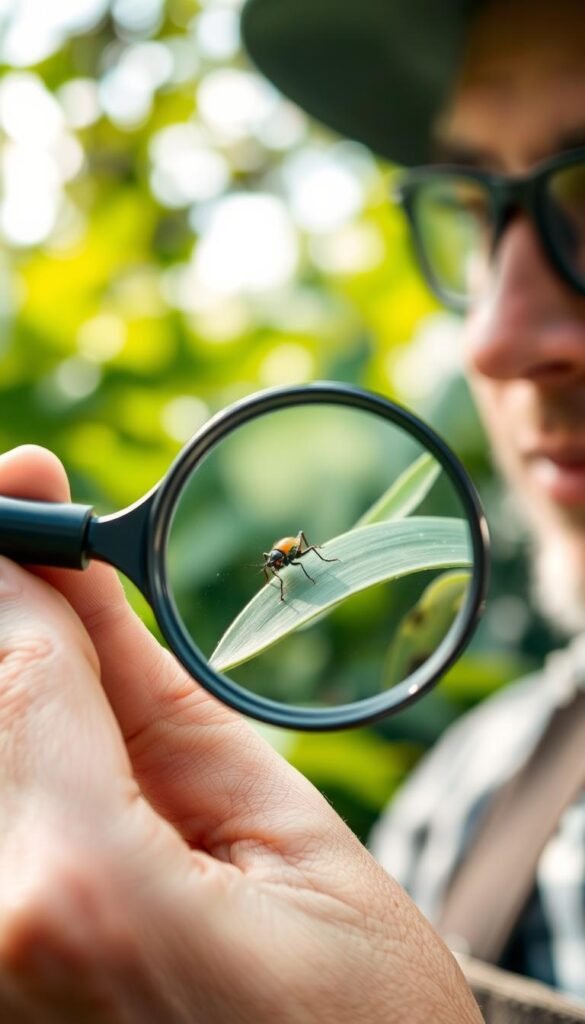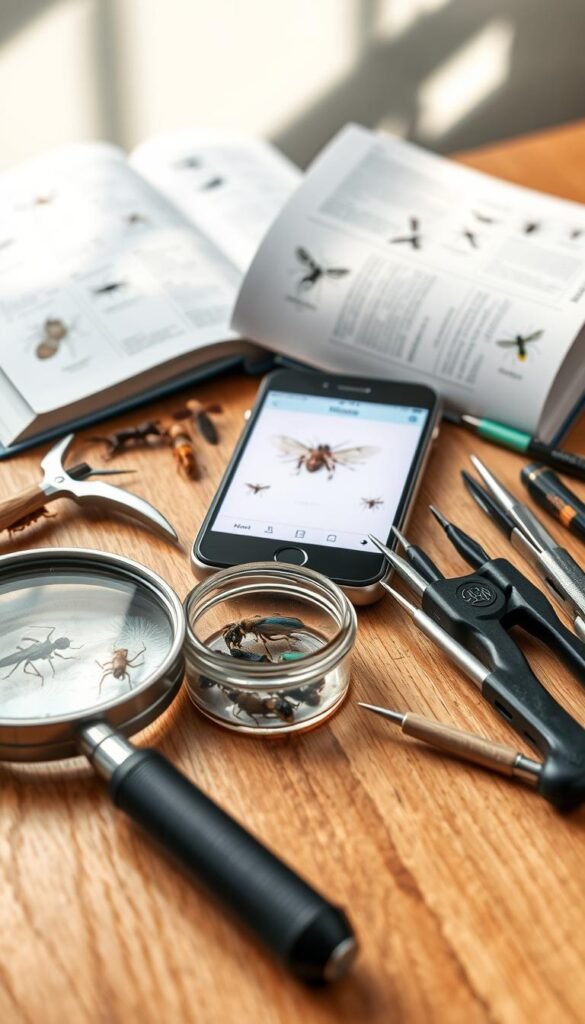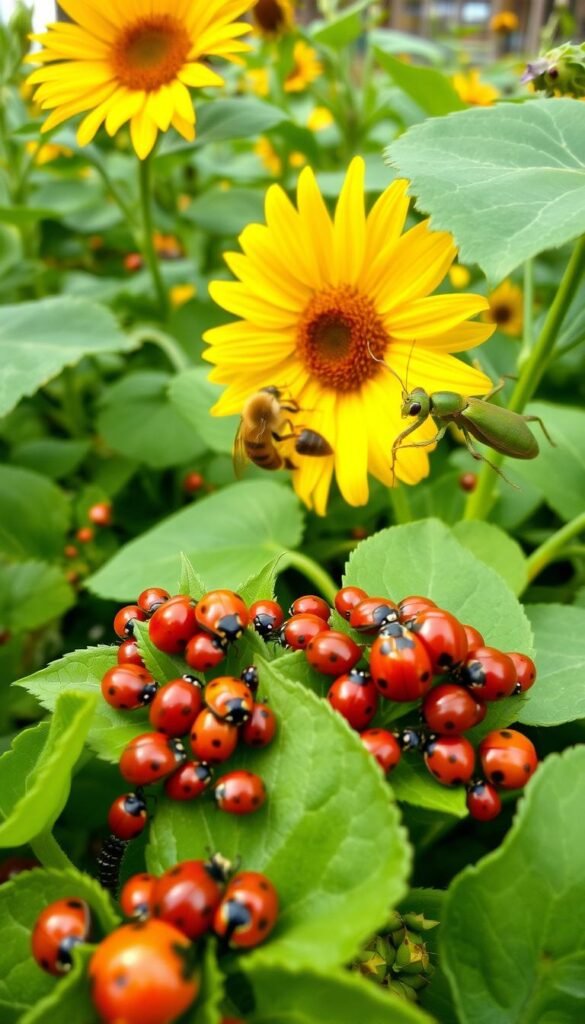Did you know over 97% of creepy-crawlies in your yard either help plants or simply mind their own business? These six-legged neighbors play vital roles – from pollinating flowers to breaking down old leaves. Learning which ones deserve a welcome mat makes gardening easier and more rewarding.
Many gardeners discover their best allies come with wings or antennae. Ladybugs snack on 50 aphids daily, while lacewing larvae hunt mites like tiny ninjas. These natural defenders reduce plant damage without chemical sprays, saving you time and money.
Smart growers use Integrated Pest Management strategies that focus on prevention first. This approach helps you spot troublemakers early while protecting helpful species. Want to try organic solutions? Our guide to organic pest control methods shows easy ways to balance your garden’s ecosystem.
Remember – most insects aren’t out to ruin your roses. With simple observation skills, you’ll soon recognize which visitors need gentle relocation and which deserve a permanent home. Your plants will thank you!
Understanding Integrated Pest Management and Garden Ecosystems
Your garden thrives when nature’s tiny helpers do the heavy lifting. A balanced ecosystem uses predators and pollinators to maintain harmony, letting you step back while they work. This approach builds resilience through diversity – like having multiple security guards instead of one.
Nature’s Pest Patrol Squad
Ladybugs aren’t just cute – their larvae eat 50 aphids daily. Lacewings devour mites, and parasitic wasps target destructive caterpillars. These allies provide free, 24/7 protection. One ladybug family can eliminate 5,000 aphids in their lifetime!
Pollinators boost your harvests too. Bees and butterflies help 3 out of 4 flowering plants reproduce. More blooms mean juicier tomatoes and fuller berry bushes. It’s teamwork – you grow habitat, they handle pollination and pest control.
Building Plant Immunity Naturally
Strong plants fight invaders better. Proper sunlight and nutrient-rich soil help them produce natural defenses. Native species often outlast exotic ones because they’re adapted to local threats.
Try these soil-boosting tips:
- Mix compost into planting beds
- Use mulch to retain moisture
- Rotate crops yearly
When your garden mimics local ecosystems, beneficial populations stabilize. You’ll spend less time battling outbreaks and more enjoying your thriving green space.
Pest Control for Beginners: Identifying Bugs vs. Beneficial Insects

Your green space hosts both friends and foes. Learning their tells helps protect helpers while managing troublemakers. Let’s explore identification through body features and daily habits.
Recognizing Physical Features and Body Structures
True allies often share specific traits. Look for three body sections – head, middle (thorax), and rear (abdomen). Bees show this clearly when landing on flowers.
Predatory species have special tools. Ground beetles sport streamlined shapes for chasing slugs. Parasitic wasps display narrow waists – like tiny hourglasses. These features help them hunt efficiently.
| Feature | Friend | Foe |
|---|---|---|
| Antennae | Long, flexible | Short, stubby |
| Wings | Clear or patterned | Thick, opaque |
| Mouthparts | Chewing or sucking | Piercing/sucking |
Distinguishing Color Patterns and Behavioral Clues
Colors shout warnings or invitations. Ladybugs wear red armor with black polka dots. Hover flies mimic wasps with yellow bands but lack stingers.
Watch daily routines. Helpful lacewings flutter near aphid colonies at dusk. Harmful cabbage worms munch leaves in daylight. Night-active ground beetles hunt slugs when you’re asleep.
Notice movement styles too. Beneficial species like mason bees dart purposefully between blooms. Destructive ones like Japanese beetles swarm erratically. Your observations become powerful detection tools!
Tips for Effective Insect Scouting and Identification

Regular check-ups keep your garden healthy, just like a doctor’s visit. Simple tools and sharp eyes help you spot troublemakers before they multiply. Let’s explore three smart methods to track your six-legged visitors.
Weekly Scouting Techniques and the White Paper Test
Flip leaves every seven days – that’s where aphids and spider mites throw secret parties. Carry a magnifying glass to spot eggs or tiny beetles. For hidden guests, try this trick:
- Hold white paper under blooms
- Gently shake stems
- Watch for falling thrips or mites
This “bug rain” reveals invaders you’d normally miss. Record counts weekly to track patterns.
Using Sticky Traps and Other Monitoring Devices
Color matters when trapping. Yellow plates catch whiteflies mid-flight, while blue snags thrips. Make your own with plastic plates and vegetable oil. Wrap stems with sticky tape to catch climbing crawlers like scale insects.
| Tool | Targets | Placement |
|---|---|---|
| Yellow trap | Aphids, whiteflies | Near seedlings |
| Blue trap | Thrips, leafminers | Flower beds |
| Sticky tape | Spider mites, scale | Plant stems |
Observing Damage Signs and Population Thresholds
Curled leaves often mean aphids are sucking sap. Yellow spots? Spider mites might be weaving trouble. Black mold follows honeydew deposits from feeding insects. Action time depends on your goals – edible plants need quicker responses than ornamentals.
Pair these methods with eco-friendly solutions for balanced management. Remember – some damage means your garden’s ecosystem is working!
Natural Pest Control Strategies for a Thriving Garden

Transform your outdoor space into a buzzing sanctuary that works smarter, not harder. Strategic plant choices and gentle interventions create self-sustaining defenses while keeping your green oasis chemical-free.
Attracting Beneficial Insects with Native and Flowering Plants
Carrot family members like dill and fennel act as parasitic wasp magnets, while mint varieties host lacewings and hoverflies. Follow this planting formula for maximum impact:
| Plant Type | Examples | Visitors |
|---|---|---|
| Flat flowers | Yarrow, Queen Anne’s lace | Ladybugs |
| Tubular blooms | Lavender, salvia | Butterflies |
| Clustered flowers | Goldenrod, native asters | Native bees |
Add water stations using shallow dishes filled with pebbles. Change water every 48 hours to keep mosquitoes away. This combo turns your plot into a five-star insect resort with free pest management included!
Employing Less Toxic Controls and Safe Pesticides
Blast aphids off roses with a hose nozzle set to “shower” mode. Handpick tomato hornworms at dawn when they’re slow-moving. For stubborn infestations, try these targeted solutions:
| Solution | Best For | Application Tip |
|---|---|---|
| Insecticidal soap | Soft-bodied insects | Spray undersides of leaves |
| Neem oil | Fungal issues + pests | Use at dusk to avoid sunburn |
| Diatomaceous earth | Crawling pests | Reapply after rain |
Always spot-test treatments and apply in the cooler hours. Your six-legged workforce will keep patrolling while these gentle methods handle the heavy lifting!
Tools and Digital Resources for Insect Identification

Your phone just became your ultimate garden sidekick. Modern technology turns tricky identifications into quick snap-and-learn moments, helping you separate plant protectors from leaf-munchers in seconds.
Mobile Apps and Online Insect Databases
Free apps like iNaturalist and Seek act like Shazam for bugs. Point your camera at a six-legged visitor – these tools compare wing patterns and body shapes against millions of records. Popular options include:
- Picture Insect: Instant matches using AI image recognition
- Google Lens: Cross-checks web resources for verification
- BugGuide.net: Expert-curated database with regional filters
Using Magnification and Macro Photography Techniques
A $10 clip-on lens reveals hidden details. Spot the hooked feet that distinguish beneficial lacewings from pests. Handheld microscopes (20-60x) expose mouthpart structures – crucial for telling friend from foe.
| Tool | Best For | Pro Tip |
|---|---|---|
| 10x loupe | Field inspections | Check for mite predators |
| Phone macro lens | Wing patterns | Use morning light |
| Pocket scope | Egg identification | Steady hands required |
Connecting with Local Experts and Online Groups
County extension offices offer free “bug clinics” where entomologists examine your samples. Join Facebook groups like Garden Insect ID Squad to crowdsource identifications. Always include:
- Clear top/side photos
- Location and date spotted
- Observed behavior notes
Build your personal digital reference library using apps’ journal features. Soon you’ll recognize your garden’s frequent fliers by their wingbeats alone!
Embracing a Sustainable Garden Ecosystem
Nature’s balance transforms your plot into a living tapestry where beneficial insects and plants work in harmony. Patience pays off – it takes up to three years for predator populations to stabilize after ditching chemicals. But the wait rewards you with a self-sustaining green space that thrives with minimal effort.
Mix flowering herbs with veggies to create a polyculture paradise. This diversity confuses plant-munching insects while feeding helpful ones. Marigolds repel root-knot nematodes, while dill attracts ladybugs that devour aphids – nature’s perfect tag team!
Your garden becomes a self-regulating haven when you let nature lead. Birds snack on caterpillars, ground beetles patrol for slugs, and lacewings lay eggs near mite colonies. These relationships strengthen your ecosystem like interconnected puzzle pieces.
Keep soil healthy with compost and mulch to support plant resilience. Rotate crops yearly to disrupt pest life cycles naturally. Over time, you’ll spend less time battling outbreaks and more enjoying your buzzing, blooming sanctuary – proof that working with nature beats fighting against it.






